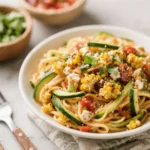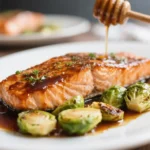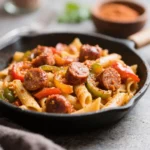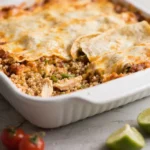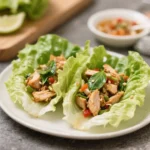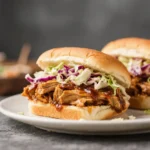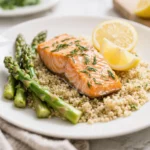Honey Balsamic Glazed Salmon with Brussels Sprouts: A Gourmet Meal Made Simple
Indulge in the rich, savory-sweet flavors of Honey Balsamic Glazed Salmon served alongside perfectly roasted Brussels sprouts. This dish combines the delicate texture of flaky salmon with the earthy crunch of caramelized sprouts, all elevated by a luxurious honey balsamic reduction that balances tanginess and sweetness in every bite. Whether you’re preparing a romantic dinner for two, hosting a family gathering, or simply treating yourself to a nutritious and satisfying meal, this recipe delivers on taste, health, and elegance—all with minimal effort.
The History of Honey Balsamic Glazed Salmon with Brussels Sprouts
While the specific combination of honey balsamic glazed salmon with Brussels sprouts is a relatively modern culinary creation, its components have deep historical roots. Salmon has long been a staple in Nordic and Pacific Northwest diets, prized for its rich omega-3 content and flavorful flesh. The use of glazes to enhance fish dates back centuries; ancient civilizations used honey as a natural sweetener and preservative, often pairing it with acidic elements like vinegar to create balanced sauces.
Balsamic vinegar, originating in Modena, Italy, has been crafted since the Middle Ages using concentrated grape must aged for years in wooden barrels. Its complex flavor profile—sweet, tart, and woody—makes it a favorite in both traditional and contemporary cuisine. Meanwhile, Brussels sprouts, named after the Belgian capital where they became popular in the 16th century, were cultivated as early as the Roman era and gained widespread popularity across Europe during the 1800s.
The fusion of these ingredients into one cohesive dish reflects the evolution of modern American and European cooking—where global flavors, healthy eating trends, and gourmet home cooking converge. Today, this recipe stands as a testament to how timeless ingredients can be reimagined into a nutritious, restaurant-quality meal that’s accessible in any home kitchen.
Ingredients Breakdown
Every ingredient in this recipe plays a crucial role in building layers of flavor, texture, and nutrition. Here’s an in-depth look at what goes into making this dish exceptional:
- Salmon Fillets (skin-on): Opt for wild-caught salmon if possible, as it offers a richer flavor and higher nutrient density compared to farmed varieties. The skin helps protect the delicate flesh during cooking and becomes delightfully crispy when seared or roasted.
- Fresh Brussels Sprouts: These mini-cabbage-like vegetables are best when firm, bright green, and free from yellowing leaves. They caramelize beautifully in the oven, developing a nutty, slightly sweet flavor that pairs wonderfully with the bold glaze.
- Balsamic Vinegar: Choose a high-quality, aged balsamic vinegar for optimal depth of flavor. Avoid inexpensive versions filled with added sugars and thickeners; authentic balsamic will elevate the glaze significantly.
- Honey: Raw, unfiltered honey adds floral notes and natural sweetness while helping the glaze caramelize on the salmon. It also contains antioxidants and antibacterial properties.
- Olive Oil: Extra virgin olive oil is used both to coat the Brussels sprouts and as a base for the glaze, contributing heart-healthy monounsaturated fats and a smooth mouthfeel.
- Garlic (freshly minced): Adds aromatic complexity and enhances umami without overpowering the other ingredients.
- Dijon Mustard: A small amount introduces tanginess and emulsifies the glaze, giving it a silky consistency that clings to the salmon.
- Lemon Juice: Freshly squeezed lemon juice brightens the entire dish, cutting through the richness of the salmon and balancing the sweetness of the honey.
- Salt and Black Pepper: Essential seasonings that enhance all other flavors. Use flaky sea salt for finishing and freshly ground black pepper for maximum aroma.
- Optional Additions: Red pepper flakes for heat, fresh thyme or rosemary for herbal notes, or toasted pine nuts/pumpkin seeds for garnish and crunch.
Step-by-Step Recipe
- Preheat the Oven: Begin by preheating your oven to 400°F (200°C). Line a large baking sheet with parchment paper or lightly grease it with olive oil to prevent sticking.
- Prepare the Brussels Sprouts: Trim the stem ends of the Brussels sprouts and remove any loose or discolored outer leaves. Cut larger sprouts in half lengthwise so they cook evenly. Place them on the baking sheet in a single layer.
- Season the Sprouts: Drizzle the sprouts with 2 tablespoons of olive oil, then sprinkle with salt, black pepper, and optionally, a pinch of garlic powder or red pepper flakes. Toss well to coat evenly.
- Roast the Sprouts: Spread the sprouts out in a single layer, ensuring they aren’t overcrowded. Roast in the preheated oven for 20 minutes, flipping halfway through, until golden brown and tender when pierced with a fork.
- Make the Honey Balsamic Glaze: While the sprouts roast, prepare the glaze. In a small saucepan over medium heat, combine ¼ cup balsamic vinegar, 3 tablespoons honey, 1 tablespoon Dijon mustard, 1 minced garlic clove, 1 tablespoon olive oil, and 1 teaspoon lemon juice. Whisk continuously until the mixture begins to simmer and thicken slightly—about 5–7 minutes. Remove from heat and set aside.
- Prepare the Salmon: Pat the salmon fillets dry with paper towels to ensure proper searing. Season both sides generously with salt and pepper. If desired, score the skin lightly with a knife to prevent curling during cooking.
- Cook the Salmon: You can choose between roasting or pan-searing:
- Oven Method: After the Brussels sprouts have roasted for 20 minutes, push them to one side of the baking sheet. Place the salmon fillets (skin-side down) on the other side. Brush the tops generously with the honey balsamic glaze. Return to the oven and bake for 12–15 minutes, depending on thickness, until the salmon flakes easily with a fork and reaches an internal temperature of 145°F (63°C).
- Stovetop Method: Heat 1 tablespoon of olive oil in a non-stick or cast-iron skillet over medium-high heat. Place salmon fillets skin-side down and cook for 5–6 minutes until the skin is crisp and golden. Flip carefully and cook for another 3–4 minutes. During the last minute of cooking, brush the top side with glaze and let it caramelize slightly. Finish under a broiler for 1–2 minutes if needed to set the glaze.
- Glaze and Rest: Once cooked, brush the salmon with additional glaze for extra shine and flavor. Let the salmon rest for 3–5 minutes before serving to allow juices to redistribute.
- Serve: Plate the roasted Brussels sprouts alongside the glazed salmon. Drizzle a little extra warm glaze over each portion and garnish with fresh herbs like chopped parsley, dill, or thyme. A final squeeze of fresh lemon juice enhances brightness.
Tips for Perfect Results Every Time
- Don’t Overcrowd the Pan: When roasting Brussels sprouts, spreading them out ensures they roast instead of steam, leading to better browning and crispier edges.
- Thicker Fillets Cook More Evenly: Choose salmon fillets of similar thickness (about 1 to 1.5 inches) to avoid uneven cooking. If one is much thinner, cover it loosely with foil during baking.
- Pat Dry Before Cooking: Moisture is the enemy of crispy skin. Always pat salmon dry before placing it in the pan or oven.
- Watch the Glaze Closely: Balsamic and honey can burn quickly due to their sugar content. Keep the heat at medium and stir frequently when reducing.
- Use a Meat Thermometer: For precise doneness, insert a thermometer into the thickest part of the salmon. Aim for 120–125°F (49–52°C) for medium-rare or 135–145°F (57–63°C) for medium to well-done.
- Let It Rest: Allow the salmon to rest after cooking to retain moisture and improve texture.
- Double the Glaze: Make extra glaze—it keeps well in the fridge for up to 2 weeks and can be used on chicken, pork, tofu, or even drizzled over salads.
- Room Temperature Start: Let salmon sit at room temperature for 10–15 minutes before cooking for more even results.
Variations and Customizations
This versatile recipe lends itself beautifully to creative adaptations based on dietary needs, flavor preferences, or seasonal availability:
- Low-Sugar Version: Replace honey with sugar-free maple syrup or monk fruit sweetener, and use a low-sugar balsamic glaze to reduce carbohydrate content—ideal for keto or diabetic diets.
- Spicy Kick: Add ½ teaspoon crushed red pepper flakes or a dash of sriracha to the glaze for a spicy twist.
- Herb-Infused: Stir chopped fresh rosemary, thyme, or tarragon into the glaze or sprinkle over the finished dish for aromatic flair.
- Citrus Variation: Substitute orange juice or zest for lemon to create a sweeter, brighter glaze profile.
- Vegan Alternative: Replace salmon with thick slabs of king oyster mushrooms, tempeh, or cauliflower steaks. Marinate and glaze as directed for a plant-based version.
- Crunchy Topping: Sprinkle toasted almonds, walnuts, pecans, or sesame seeds over the Brussels sprouts before serving for added texture.
- Creamy Element: Serve over mashed cauliflower, quinoa, or couscous and add a dollop of Greek yogurt or herbed cream cheese for richness.
- Sheet Pan Dinner: For easier cleanup, cook everything together on one sheet pan—just place salmon on the tray after sprouts have partially roasted to avoid overcooking.
- Asian Fusion: Swap balsamic for tamari or soy sauce, honey for maple syrup, and add ginger and sesame oil to the glaze. Top with scallions and sesame seeds.
- Smoked Salmon Option: Use smoked salmon slices as a topping for roasted sprouts and warm through gently, drizzling with a reduced glaze just before serving.
Health Considerations and Nutritional Value
Honey Balsamic Glazed Salmon with Brussels Sprouts isn’t just delicious—it’s packed with nutrients that support overall wellness:
- Omega-3 Fatty Acids: Salmon is one of the best sources of EPA and DHA, essential fats known to support brain function, reduce inflammation, and promote heart health.
- Fiber-Rich Vegetables: Brussels sprouts are high in dietary fiber, aiding digestion and promoting gut health. They also contain glucosinolates, sulfur-containing compounds studied for their potential cancer-fighting properties.
- Antioxidants: Both salmon and Brussels sprouts are rich in antioxidants like selenium, vitamin C, and kaempferol, which help combat oxidative stress.
- Protein Powerhouse: This meal provides approximately 25–30 grams of high-quality protein per serving, supporting muscle repair and satiety.
- Healthy Fats: Olive oil and salmon contribute monounsaturated and polyunsaturated fats, beneficial for cholesterol levels and cardiovascular health.
- Natural Sweeteners: Honey, though calorie-dense, contains trace enzymes, vitamins, and minerals not found in refined sugar. However, moderation is key, especially for those managing blood sugar.
- Low Carb & Gluten-Free: Naturally gluten-free and suitable for low-carb or paleo diets when adjusted appropriately.
- Vitamins and Minerals: This dish delivers significant amounts of vitamin B12, vitamin D, vitamin K, folate, potassium, and magnesium.
Nutritional Estimate (per serving, assuming 6 oz salmon and 1 cup sprouts):
- Calories: ~420 kcal
- Protein: 32g
- Fat: 24g (mostly healthy fats)
- Carbohydrates: 18g
- Fiber: 6g
- Sugar: 10g (primarily from honey and natural vegetable sugars)
- Sodium: ~400mg (adjustable by reducing added salt)
Note: Values may vary based on ingredient brands and portion sizes. To lower calories or fat, reduce oil usage or glaze quantity.
Ingredients
- 4 (6 oz) skin-on salmon fillets
- 1 lb fresh Brussels sprouts, trimmed and halved
- 3 tablespoons extra virgin olive oil (divided)
- Salt and freshly ground black pepper to taste
- ¼ cup balsamic vinegar (preferably aged)
- 3 tablespoons raw honey
- 1 tablespoon Dijon mustard
- 2 cloves garlic, minced
- 1 teaspoon fresh lemon juice
- Optional: red pepper flakes, fresh herbs (parsley, thyme), lemon slices for garnish
Directions
- Preheat oven to 400°F (200°C). Line a large baking sheet with parchment paper.
- In a bowl, toss Brussels sprouts with 2 tablespoons olive oil, salt, and pepper. Spread in a single layer on the baking sheet.
- Roast for 20 minutes, flipping halfway, until tender and golden.
- While sprouts roast, make the glaze: In a small saucepan, combine balsamic vinegar, honey, Dijon mustard, garlic, 1 tablespoon olive oil, and lemon juice. Simmer over medium heat for 5–7 minutes, stirring often, until slightly thickened. Set aside.
- After 20 minutes, push sprouts to one side of the baking sheet. Place salmon fillets skin-side down on the other side.
- Brush salmon generously with glaze. Return to oven and bake for 12–15 minutes, until salmon flakes easily and reaches desired doneness.
- Remove from oven, brush with more glaze, and let rest 5 minutes.
- Serve warm, garnished with fresh herbs and a lemon wedge. Drizzle with extra glaze if desired.
FAQ
Can I use frozen Brussels sprouts?
Yes, but fresh yields superior texture and flavor. If using frozen, thaw completely and pat dry to remove excess moisture before roasting.
Can I make this ahead of time?
You can prep the glaze and chop the sprouts up to a day in advance. Store separately in airtight containers. Assemble and cook just before serving for best results.
Is this recipe safe for pregnant women?
Yes, as long as the salmon is fully cooked to 145°F (63°C), which kills harmful bacteria and parasites. Wild-caught salmon is generally lower in contaminants than some farm-raised options.
How do I store leftovers?
Store cooled salmon and sprouts in separate airtight containers in the refrigerator for up to 3 days. Reheat gently in the oven or toaster oven to preserve texture.
Can I freeze this dish?
Freezing is not recommended for cooked salmon, as it tends to become dry and mealy upon reheating. The glaze and raw ingredients freeze better.
What sides go well with this meal?
Try creamy mashed potatoes, wild rice pilaf, quinoa, sautéed spinach, or a simple arugula salad with a lemon vinaigrette.
Why did my glaze turn out too thin/thick?
If too thin, simmer longer to reduce. If too thick, whisk in 1–2 teaspoons of water or apple juice to loosen. Cool slightly before applying to salmon.
Can I grill the salmon instead?
Absolutely! Preheat grill to medium-high, oil the grates, and grill salmon skin-side down for 5–6 minutes, flip, glaze, and cook 2–3 minutes more.
Summary
Honey Balsamic Glazed Salmon with Brussels Sprouts is a harmonious blend of sweet, tangy, and savory flavors, delivering a nutritious and visually stunning meal perfect for weeknights or special occasions. With simple ingredients, easy preparation, and endless customization options, this dish proves that healthy eating can be both delicious and elegant.

